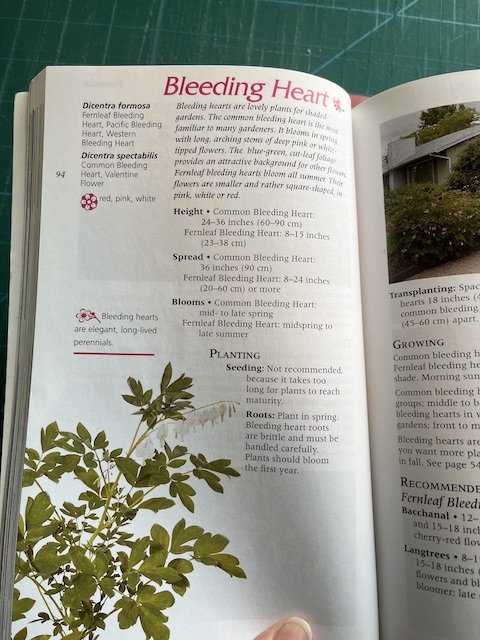Part 4: The Plants (taking gardening dreams into reality)
In parts 1, 2 and 3, we covered everything from listing all our dreams, choosing the location, determining your climate, sketching out our plans and finally breaking down your budget.
Today we’re going to dip our toes into the plant world.
Get some reference material
In part 2, we created some sketches on graph paper with approximate plant sizes. Now it’s time to take those loose shapes and put actual plants with the correct sizes into the plan.
If you need reference books for tree and shrub sizes, your library will help you out.
A great resource is any of Lois Hole’s books. She has ones on Trees and Shrubs, Perennials and Annuals. They’re an easy read (includes mature plant sizing), and all the plant material she recommends grows in Alberta!
How to choose the plants
Remember back in Part 2, you determined your climate? Now it’s time to grab that list and your reference books.
All plants have a preferred location for growing. Your reference books will list either Full Sun, Partial Sun/Shade or Full Shade.
If you try to grow your plants in the wrong area, they'll struggle and never grow to their most beautiful self.
If you have an existing yard with fully mature trees and almost completely shaded, don’t expect to grow full-sun perennials. They will grow, but will probably never bloom. They’ll grow leggy and floppy stretching for the sun.
The opposite will happen if you try to grow full-shade plants in the hot open sun. Their leaves are going to burn and dry up and be crispy-looking all season.
Design Tips
Keep large trees away from the foundation of your home. Those roots can potentially erode your foundation.
Unless you need privacy, plant your trees away from your large picture window to allow for sunlight and to see your view.
Keep smaller plants to the front of the bed so they don’t get lost.
Mix up your plant shapes. Try some tall airy plants next to short and squat plants.
Be artistic and plant things beside each other that might not make sense. If it doesn’t work, just move them!
Mix spring blooming plants with mid and late season bloomers, so you have a garden filled with blooms all season.
Don’t overwhelm yourself thinking you need 30 different plants. Focus on a small selection and mix them in throughout the entire bed.
Start with your trees and shrubs
There are 2 types of trees: Deciduous and Coniferous.
Deciduous trees will lose their leaves. They can be large shelterbelt trees like Poplar and Willow or smaller ornamental trees like flowering Crabapples down to your smaller Spirea.
Coniferous trees are your evergreen trees. From large Lodgepole pines and Colorado Blue Spruce to smaller dwarf Mugo pines.
Take the time to draw out large circles on your sketch with mature sizes. This will give you an idea of how wide your trees and shrubs are going to grow.
You’ll be surprised at how far you’ll have to plant those trees away from the house. The canopy of trees is often wider than we think.
Remember that just because the tree canopy is 15 ft wide, doesn’t mean we can’t grow plants under the Deciduous trees.
Next, add perennials and annuals
Once you know the space left in your garden beds start adding in your perennials. You can leave open space in your design if you love to mix in annuals every spring.
You can either go into super fine detail and mark every single perennial with its own little circle or create a larger bubble shape and label it perennials with a list of your plants on a piece of paper.
These plants can be added to or moved as the years go by. When a garden is new and the trees are small, there will be more sun available. You’ll be able to grow more full-sun perennials.
As trees mature, you may have to move out plants that no longer are suitable for the increased shade.
Where to find plants?
Plant material can be found in a lot of places now. I’ve seen plants at my local grocery store, outside small variety stores, hardware stores, large supermarkets, big box hardware stores, mail-order catalogues, large-scale greenhouses and nurseries and of course your little mom-and-pop greenhouses (like mine).
The biggest thing to remember when you’re buying plants is to look at the health of each plant.
No matter where you buy it, if it has been cared for, looks in good health with good branching and is not dried out you should be good to purchase the plant material.
I’m partial to greenhouses, nurseries and mom and pop greenhouses. You know they’ve taken the time to educate their staff on proper care of plant material. You should be getting the best quality plants from these businesses.
Not my greenhouse - Photo used with permission
When in doubt ask questions
If you’re still feeling unsure about what to plant, ask for help.
Ask the neighbour down the road with the beautiful yard. The garden centre staff will be able to walk you through the greenhouse and point out plants that will work.
If you still need more help, reach out to a landscape designer. They can take your sketch and build on it to reach your end goal.
But, most of all, be willing to try! No garden is ever truly finished. It’s all a work in progress. Take risks, choose plants and get gardening.
You might lose some plants, but you’ll gain confidence and joy in your garden!
Till the snow melts……Happy Dreaming!
Heidi




